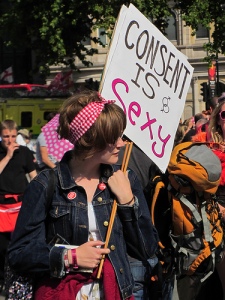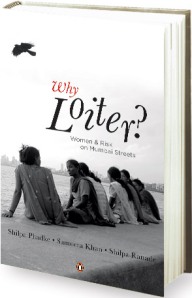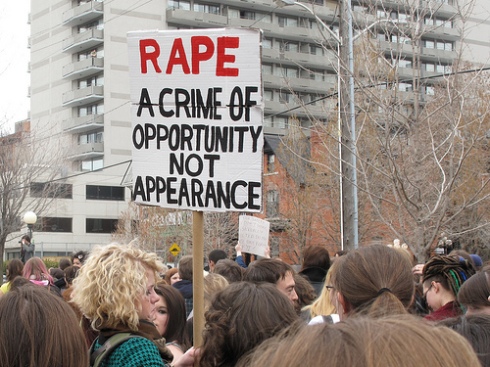1. ONE afternoon almost a decade ago I was walking from my house in Bombay to Breach Candy, a 15-20 walk, and about five minutes in, I noticed that there was a man following me. I don’t remember what he looked like, or what he was wearing—he was a typical Roadside Romeo, one of those lewd, cat-calling types who like to sing suggestive Bollywood songs and make like an octopus with their grabby hands, that women in India encounter daily on the streets.
I had been followed by men before, and I tried all my usual tricks to throw him off. I stopped to enjoy the view of a park, hoping he would pass me by. He didn’t. I strolled into a nearby store, browsing the jewellery on sale, lingering over the silver section, but when I walked back out, he was across the street, waiting. Our eyes met and he gave me a cheeky wave. I had been irritated before, but now I was seething. On the next corner I saw a policeman, and I stalked right up to him. The words rushed out of me, how this person had followed me all the way from home, and how I had tried to lose him but he kept right behind me, and now this, the final straw, him waving knowingly, as though to say, “I’m still here. I’ll always be here. You can never be free on the streets of the city.”
While I was talking, people started listening in, as they are wont to do, and offering their own opinions. One Parsi lady, with hair fully white and cut in a bob, offered her support and congratulated me on doing something about it. Two women in salwar kameezes nodded knowingly; this had happened to them many times. A few men, enraged on my behalf, marched over to the man, who by this point was trying to slink away, unnoticed. They dragged him over to face the policeman, and I, who am not normally known for my bloodthirstiness, I was fiercely glad. They formed a knot around the man, who had no more sly smiles left in him, and I heard the sound of palm meeting flesh.
I walked away then, feeling powerful and vindicated. This was for all those times that a man had stuck out a hand and grabbed a body part that did not belong to him, for those moments of embarrassment and humiliation when I had had to walk past a group of men who were determined to undress me with their eyes, for the shock and violation caused by their crude comments and the baring of their privates—something that every woman, in India and around the world, has had to endure at some point or another in their life.
2. That’s why I’m so glad that an organization like Hollaback! exists, and that it has come to India. Hollaback! is an international movement to stop street harassment using mobile technology. Their “about” page says:
Street harassment is one of the most pervasive forms of gender-based violence and one of the least legislated against… [It] is rarely reported, and it’s culturally accepted as ‘the price you pay’ for being a woman or for being gay. At Hollaback!, we don’t buy it.
We believe that everyone has a right to feel safe and confident without being objectified. Sexual harassment is a gateway crime that creates a cultural environment that makes gender-based violence OK… The explosion of mobile technology has given us an unprecedented opportunity to end street harassment… By collecting women and LGBTQ folks’ stories and pictures in a safe and share-able way with our very own mobile phone applications, Hollaback! is creating a crowd-sourced initiative to end street harassment. Hollaback! breaks the silence that has perpetuated sexual violence internationally, asserts that any and all gender-based violence is unacceptable, and creates a world where we have an option—and, more importantly—a response.
The way it works is this: if you have been harassed, you can take a photograph of the harasser with your smartphone (using their Droid or iPhone app; global apps to come this summer) or a digital camera, if you have one handy, map your location, and share your story on your local Hollaback! website. And as the Mumbai site says, participate in the Main Hoon Na! campaign: “The Main Hoon Na Campaign provides real options to people who want to help end street harassment with a simple message: If you see someone being harassed, go to them and ask them if they are OK, and if there is anything you can do to help.”
It’s simple, but powerful. So the next time you see someone on the street being harassed by a Roadside Romeo, shout, make a ruckus, tell a cop, take a photograph, or simply offer your support.
Speaking of safely strolling down the street, a book came out earlier this year which addresses this very issue and I am dying to read it. It’s called Why Loiter? Women and Risk on Mumbai Streets and it’s by three formidable women, Shilpa Phadke, Sameera Khan, and Shilpa Ranade. The authors argue that “though women’s access to urban public space has increased, they still do not have an equal claim to public space in the city” and they draw from feminist theory to argue that “only by celebrating loitering—a radical act for most Indian women—can a truly equal, global city be created.”
Mumbai is famously safe. Unlike Delhi, which has acquired a bhayanak reputation, what with taxi drivers raping tourists and terrible tales of gang rape at gunpoint, Mumbai is supposed to be safe for women (well, relatively speaking, anyway). And indeed, even with my occasional encounters with leering, lunging men, I usually feel safe in my hometown as well. Why Loiter? shatters that belief.
As this review in Himal says:
The authors take us on an insightful and eventful journey, though one that leaves the reader a mite frazzled. Whirring through the bustling bylanes of Dongri and Nagpada, the posh Malabar Hill and Ballard Estate, middle-class Shivaji Park and the teeming gallis of Dharavi, we glimpse the array of women out on the streets, in the bus stops and parks. They take us on a desperate (and unsuccessful) search for a ‘ladies’ toilet in Andheri Station; a squashy ride in the ubiquitous local train; leave us breathless after a brisk walk across the Oval Maidan, where no woman must linger; and finally allow us to feel the sea breeze on the Marine Drive promenade. The book breathes Bombay, Bambai and Mumbai; it never lets us forget that there are distinct worlds in this city of 21 million. From the eyes of women, these worlds, separated by class, caste and religion, are hard to reconcile with the stereotypes of the freewheeling ‘Bombay girl’.
In a section on public toilets, the authors write, “If public toilets were to be your guide to imagining the city, what would they say about Mumbai? First, they would imply that there are very few women in public as compared to men… Second, they would suggest that if Mumbai women need to pee, they do so at home… And third, they would say, since even fewer facilities are open after 9pm, respectable women have no business being out in public after dark.”
Loitering without purpose, they say, is a way to reclaim public space, and I am going out right now (ok, when I finish this post) to go do some loitering of my own. It’s on the streets of New York, true, but no doubt I will attract at least a curious, assessing glance or two. I will go stand on the street corner, and not pretend to be texting someone, or waiting for a friend, looking impatiently at my watch, or window-shopping while walking slowly to my destination. I will loiter, because it’s my city too, and I am claiming its streets.
I am going to do my part in creating a city “with street corners full of women: chatting, laughing, breastfeeding, exchanging corporate notes or planning protest meetings. If one can imagine that, one can imagine a radically altered city.”
3. Many of you will have heard by now of the SlutWalk movement which began in Toronto this past January when a local cop, Constable Michael Sanguinetti, told students at York University during a safety information session that “women should avoid dressing like sluts in order not to be victimized.” Despicable remarks, and from someone who should have known better. People get assaulted every day, regardless of what they are wearing. The madonna/whore dichotomy is ancient and damaging and sadly, still in use. The women in Toronto had had enough, and they organized a SlutWalk, a march of women down to the police headquarters, in protest.
The movement spread like wildfire around the world, and to India: Delhi will hold its first SlutWalk in July. Though the word “slut” itself doesn’t hold the resonance in India that it does in the rest of the English-speaking world, the sentiment behind it is the same. As this DNA India article detailed:
According to the National Crime Records Bureau (NCRB), there is a rape every 18 hours, and molestation every 14 hours in Delhi. One of every four rapes in India is committed in the capital. Only one in 69 rape cases in India are reported; just 20% of these cases result in conviction of the rape accused. In other words, the chance of a rapist being sent to jail is 0.28%.
These are figures we should all be bitterly ashamed of—and do something to change. You can start by listening to Jaclyn Friedman’s amazing speech at the Boston SlutWalk. Here are a few snippets:
Well hello you beautiful sluts!
Do you see what I did there? I called y’all sluts, and I don’t know the first thing about what any of you do with your private parts. (Well, maybe I know about a couple of you, but I’ll never tell.)
That’s how the word “slut” usually works. If you ask ten people, you get ten different definitions. Is a slut a girl who has sex too young? With too many partners? With too little committment? Who enjoys herself too much? Who ought to be more quiet about it, or more ashamed? Is a slut just a woman who dresses too blatantly to attract sexual attention? And what do any of these words even mean? What’s too young, too many partners, too little committment, too much enjoyment, too blatant an outfit? For that matter, what’s a woman, and does a slut have to be one?
For a word with so little meaning, it sure is a vicious weapon. And, while the people who use it to hurt may not agree on what they mean by it, they’ll all agree on one thing: a slut is NOT THEM. A slut is other. A slut is someone, usually a woman, who’s stepped outside of the very narrow lane that good girls are supposed to stay within. Sluts are loud. We’re messy. We don’t behave. In fact, the original definition of “slut” meant “untidy woman.” But since we live in a world that relies on women to be tidy in all ways, to be quiet and obedient and agreeable and available (but never aggressive), those of us who color outside of the lines get called sluts. And that word is meant to keep us in line. To separate us. To make us police each other, turn on each other, and turn each other in so that we can prove we’re not “like that.” That word comes with such consequences that many of us rightly work to avoid it at all costs.
But not today. Today we all march under the banner of sluthood. Today we come together to say: you can call us that name, but we will not shut up. You can call us that name but we will not cede our bodies or our lives. You can call us that name, but you can never again use it to excuse the violence that is done to us under that name every single fucking day.
Friedman ended with this rousing call:
If you’ve ever been called a slut, stand up now and say together—I am a slut. If you love someone who’s been called a slut—stand up now and say, I am a slut. If you’ve ever been afraid of being called a slut, stand up now and say, I am a slut. If you’ve been blamed for violence that someone else did to you, stand up now and say, I am a slut. If you’re here to demand a world in which what we do with our bodies is nobody’s business, and we can all live our lives and pursue our pleasures free of shame, blame and free, stand up and say it with me: I am a slut. I am a slut. I am a slut.
So SlutWalk Delhi, ignore the catcalls and the cynics who will try to pull you down, and let’s all say together: You can call me a slut, or a kutiya (bitch), a chinaal or randi (whore), but that doesn’t give you the license to commit violence upon my body.
4. And thanks to my friend Meghana for bringing this excellent HuffPo article to my attention. (Meghana has a little girl of her own, who’s so smart she can say my name already, so she’s on top of this parenting stuff.) In it, the author recounts meeting the five-year-old daughter of a friend for the first time. Despite wanting to coo over how adorable she looked, the author made herself talk to the child about her love for books. Because it’s the constant discussing and praising of the way our daughters look—over the praising of achievements—that has led to the American girl’s obsession with physical appearance.
This week ABC news reported that nearly half of all three- to six-year-old girls worry about being fat. In my book, Think: Straight Talk for Women to Stay Smart in a Dumbed-Down World, I reveal that fifteen to eighteen percent of girls under twelve now wear mascara, eyeliner and lipstick regularly; eating disorders are up and self-esteem is down; and twenty-five percent of young American women would rather win America’s Next Top Model than the Nobel Peace Prize. Even bright, successful college women say they’d rather be hot than smart. A Miami mom just died from cosmetic surgery, leaving behind two teenagers. This keeps happening, and it breaks my heart.
Read the entire article here. And the next time you see that little girl in your life, give her a book. Maybe Tina Fey’s Bossypants.










Two comments on your post:
1) As a Bombayite, I can’t tell you how often I have been subjected to gropers, followers, lechers etc. etc. and I am glad that you are bringing it up and talking about what women of all ages face daily in Bombay. I wish more people helped out when women are obviously made to feel uncomfortable. Unfortunately these guys usually target younger and more vulnerable girls who might not speak out. The next time you see something, do something.
2) As Misha’s mum, I feel I must comment on the article I posted on FB. Some people read it as, don’t ever praise a girl’s appearance. I think it’s fine to praise a child (boy or girl) if they look cute, however we need to make sure we notice things other than their appearance. As a society we are too focussed on looks, clothes and possessions and less on character. Next time you see my daughter, tell her how smart, loving and kind she is and then tell her she looks great! Then she will turn out perfect like me 🙂